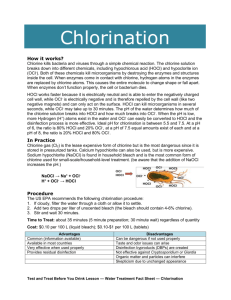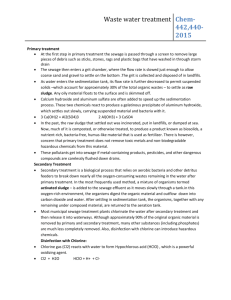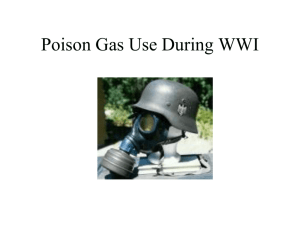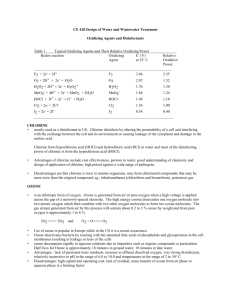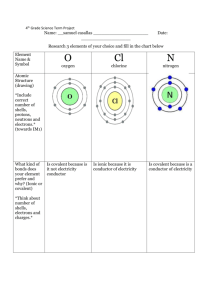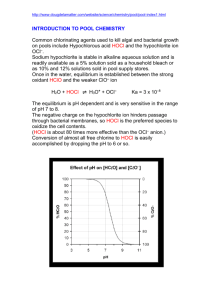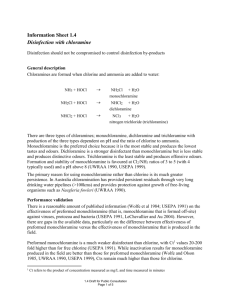Disinfection of water
advertisement
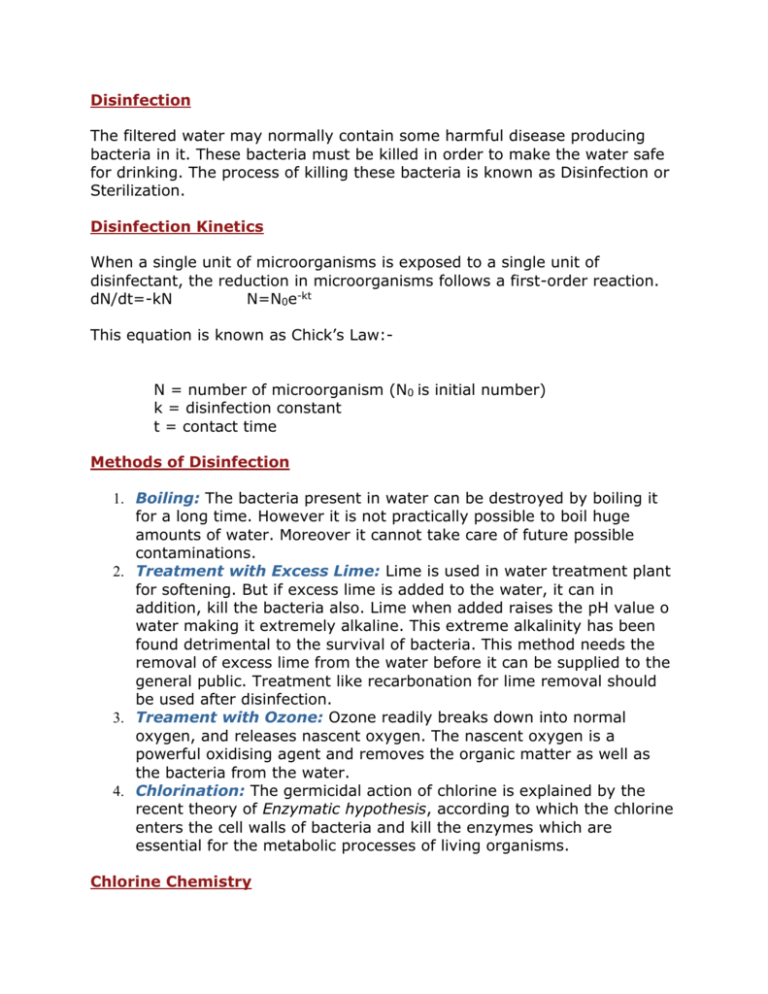
Disinfection The filtered water may normally contain some harmful disease producing bacteria in it. These bacteria must be killed in order to make the water safe for drinking. The process of killing these bacteria is known as Disinfection or Sterilization. Disinfection Kinetics When a single unit of microorganisms is exposed to a single unit of disinfectant, the reduction in microorganisms follows a first-order reaction. dN/dt=-kN N=N0e-kt This equation is known as Chick’s Law:N = number of microorganism (N0 is initial number) k = disinfection constant t = contact time Methods of Disinfection 1. Boiling: The bacteria present in water can be destroyed by boiling it for a long time. However it is not practically possible to boil huge amounts of water. Moreover it cannot take care of future possible contaminations. 2. Treatment with Excess Lime: Lime is used in water treatment plant for softening. But if excess lime is added to the water, it can in addition, kill the bacteria also. Lime when added raises the pH value o water making it extremely alkaline. This extreme alkalinity has been found detrimental to the survival of bacteria. This method needs the removal of excess lime from the water before it can be supplied to the general public. Treatment like recarbonation for lime removal should be used after disinfection. 3. Treament with Ozone: Ozone readily breaks down into normal oxygen, and releases nascent oxygen. The nascent oxygen is a powerful oxidising agent and removes the organic matter as well as the bacteria from the water. 4. Chlorination: The germicidal action of chlorine is explained by the recent theory of Enzymatic hypothesis, according to which the chlorine enters the cell walls of bacteria and kill the enzymes which are essential for the metabolic processes of living organisms. Chlorine Chemistry Chlorine is added to the water supply in two ways. It is most often added as a gas, Cl2(g). However, it also can be added as a salt, such as sodium hypochlorite (NaOCl) or bleach. Chlorine gas dissolves in water following Henry's Law. Cl2(g) Cl2(aq) KH =6.2 x 10-2 Once dissolved, the following reaction occurs forming hypochlorous acid (HOCl): Cl2(aq)+H2O HOCl + H+ + ClHypochlorous acid is a weak acid that dissociates to form hypochlorite ion (OCl-). HOCl OCl- + H+ Ka = 3.2 x 10-8 All forms of chlorine are measured as mg/L of Cl2 (MW = 2 x 35.45 = 70.9 g/mol) Hypochlorous acid and hypochlorite ion compose what is called the free chlorine residual. These free chlorine compounds can react with many organic and inorganic compounds to form chlorinated compounds. If the products of these reactions posses oxidizing potential, they are considered the combined chlorine residual. A common compound in drinking water systems that reacts with chlorine to form combined residual is ammonia. Reactions between ammonia and chlorine form chloramines, which is mainly monochloramine (NH2Cl), although some dichloramine (NHCl2) and trichloramine (NCl3) also can form. Many drinking water utilities use monochloramine as a disinfectant. If excess free chlorine exits once all ammonia nitrogen has been converted to monochloramine, chloramine species are oxidized through what is termed the breakpoint reactions. The overall reactions of free chlorine and nitrogen can be represented by two simplified reactions as follows: Monochloramine Formation Reaction. This reaction occurs rapidly when ammonia nitrogen is combined with free chlorine up to a molar ratio of 1:1. HOCl +NH3 NH2Cl + HOCl Breakpoint Reaction: When excess free chlorine is added beyond the 1:1 initial molar ratio, monochloramine is removed as follows: 2NH2Cl + HOCl N2(g)+ 3H++ 3Cl-+ H2O The formation of chloramines and the breakpoint reaction create a unique relationship between chlorine dose and the amount and form of chlorine as illustrated below. Free Chlorine, Chloramine, and Ammonia Nitrogen Reactions Chlorine Demand Free chlorine and chloramines readily react with a variety compounds, including organic substances, and inorganic substances like iron and manganese. The stoichiometry of chlorine reactions with organics can be represented as shown below: HOCl: 1/10C5H7O2N + HOCl 4/10CO2 + 1/10HCO3- + 1/10NH4++ H+ + Cl- + 1/10H2O OCl-: 1/10C5H7O2N + OCl- 4/10CO2 + 1/10HCO3- + 1/10NH4++ Cl- + 1/10H2O NH2Cl: 1/10C5H7O2N + NH2Cl + 9/10H2O 4/10CO2 + 1/10HCO3- + 11/10NH4++ Cl- Chlorine demand can be increased by oxidation reactions with inorganics, such as reduced iron at corrosion sites at the pipe wall.

